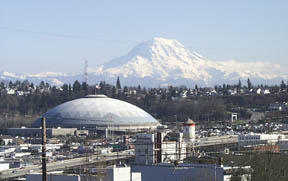Outdoor warning sirens in the Puyallup and Carbon River valleys will be activated Monday morning as Pierce County tests its Mount Rainier lahar warning system.
According to U.S. Geological Survey (USGS) scientists, lahars – an Indonesian word for volcanic mudflow – from Mount Rainier are the primary hazard to developed areas in the valley, including Orting, Sumner, Puyallup and Fife.
The addition of the evacuation sirens in the Puyallup valley provides a critical early warning mechanism that can help save lives, Pierce County Emergency Management Director Steve Bailey said in a press release. Sirens and evacuations are a critical reminder to residents and visitors alike that the valley is potentially at risk should Mount Rainier become restless again.
Mondays test focuses on those areas that would be most affected by a mudflow off Mount Rainier, although the volcanos geologic history includes some debris flows that have traveled as far as the present margins of Puget Sound and much of the lowlands east of Tacoma.
About 5,600 years ago, the Osceola mudflow traveled down the White and Nisqually Rivers, reaching the Puget Sound, eventually arriving at the Tacoma Tideflats, explained Carolyn Driedger, a hydrologist with Cascades Volcano Observatory in Vancouver, Wash.
The 500-year-old Electron lahar – which covered what is now Orting with a mudflow traveling at 20 mph and a debris wall 20 feet high – is the last major mudflow on record.
Landslides happen when part of a mountain collapses and slides away from the rest of the mountain. The failed mass rapidly breaks up into a jumble of pieces that flows at a high velocity like a liquid.
Tacoma would not be directly affected, Driedger said, referring to any large mudflow that might occur presently. Its rare for any lahar to travel outside the boundaries of Mount Rainier National Park, she said.
Lahars are far-reaching hazards, because they get funneled down valleys, she said. The biggest problem for the Tacoma area would be presented by post-lahar sedimentation, where sufficient material is carried downstream over a period of years or decades, filling in stream beds, which displaces water, causing flooding.
When Mount Rainier does have a large-scale eruption, everybody in the area will be affected, Driedger said, although she noted that any ash spewed from such an eruption would be carried to less populated areas, because the wind blows from west to east.
Low-lying areas of Tacoma would be affected, mostly causing transportation-related problems affecting the Interstate 5 corridor, the Port of Tacoma and the Tacoma Tideflats, said Jody Woodcock, Emergency Management spokesperson.
A slight disruption can have a big economic impact, she said.
In the event of a big eruption and accompanying debris flow, lowland residents would be advised to get to higher ground, she said.
Theyve (City of Tacoma) always been willing to work with us, Woodcock noted.
Mount Rainier remains quiet and shows no signs of volcanic activity. The volcanos last period of activity occurred between 1820 and 1854, with 14 recorded eruptions that covered surrounding areas with a fine layer of pumice.
Scientists have found, however, that some large lahars caused by landslides – such as the Electron lahar – may not have been accompanied by volcanic unrest.
You cant think that its going to be an eruption that triggers a lahar, Driedger said.
Other causes of debris flow include intense rainfall and glacial-outburst floods.
Mondays technical drill is meant to test the alert call-down process and allow the monitoring of sound coverage throughout the Puyallup and Carbon River valleys.
The test is designed to help citizens recognize the warning sirens, learn their evacuation routes and prepare to be on their own for 72 hours.
We have people all over the valley to let us know if the sirens can be heard, Woodcock said.
In addition to the activation of the warning sirens – which will run for three to five minutes – local media may run the Emergency Alert Signal (EAS) test.
Also, National Oceanic and Atmospheric Administration (NOAA) weather radios will be activated.
I know they are very, very loud, Woodcock said of the sirens, which she compared to air raid sirens people may be familiar with.
(Of course, many people in Orting are already familiar with how loud the sirens are, after a technician preparing for the Oct. 28 test accidentally flipped the wrong switch and triggered the siren this past Monday afternoon.)
A total of 14 sirens will be involved in next weeks test.
Residents, business and schools in the area have been encouraged to participate, but are not required to conduct evacuation drills.
Schools in Orting and Sumner will coordinate their annual evacuation drills with the siren test. A few schools in Puyallup will also take part in the drill. The drills range from partial practices to full-scale simulations, Woodcock said.
Plans call for an additional siren at the Riverside Fire Department near Puyallup and two in unincorporated areas between Orting and Sumner.
The Riverside Fire Department siren is currently in the permitting process, Woodcock said, and is tentatively scheduled to be operational in the next month or so.
Mondays test is set to begin at 10 a.m





